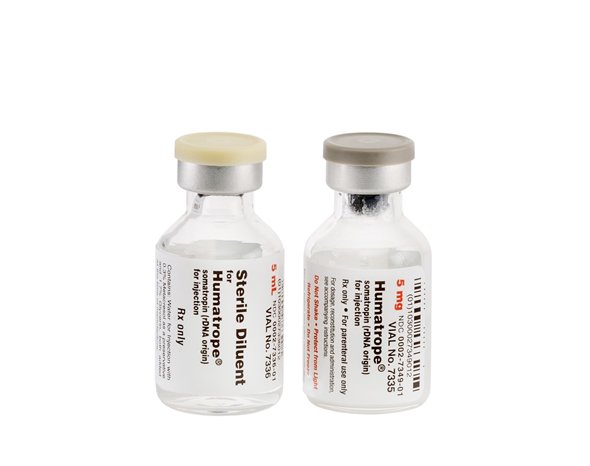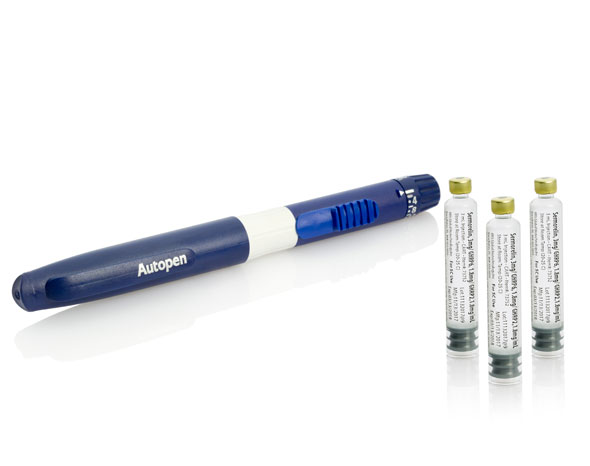- Home
- Growth Hormone
- Growth Hormone
- Growth Hormone Deficiency
- Growth Hormone Therapy
- Growth Hormone Injections
get startedThe Most Effective Hormone Replacement TherapiesHumatrope
- General Info
- Benefits
- Side Effects
- Interactions
- Warnings
- Administration
- Reviews

What Is Humatrope® Used For?
Humatrope® is a man-made form of human growth hormone made using recombinant DNA (rDNA). It is manufactured by Lilly. Humatrope® is used to treat children who do not make enough growth hormone on their own, have Turner Syndrome, idiopathic short stature, have SHOX deficiency, and/or were born smaller than normal for the number of weeks of pregnancy and do not catch up in height by 2 to 4 years of age.
In adults, Humatrope® is used to treat growth hormone deficiency that began in childhood and has continued, or in adulthood that has occurred as the result of pituitary disease, hypothalamic disease, surgery, radiation therapy, or trauma.
Dosage Forms and Strengths Available
Humatrope® is a sterile, white, lyophilized powder intended for subcutaneous or intramuscular administration after reconstitution to its liquid form. Each vial of Humatrope contains 5 mg somatropin (15 IU or 225 nanomoles); 25 mg mannitol; 5 mg glycine; and 1.13 mg dibasic sodium phosphate. Each vial is supplied in a combination package with an accompanying 5-mL vial of diluting solution (diluent). The diluent contains Water for Injection with 0.3% metacresol as a preservative and 1.7% glycerin.
Humatrope® is available as:
- 5 mg vial and 5-mL vial of Diluent for Humatrope
- 6 mg (gold), 12 mg (teal) and 24 mg (purple) cartridge, and prefilled syringe of Diluent for Humatrope
- Humatrope cartridges should be used only with the appropriate corresponding pen device
In people with growth hormone deficiency, Humatrope® has been shown in clinical trials to – be therapeutically equivalent to Human Growth Hormone of pituitary origin and achieves equivalent effects in the stimulation of linear growth. In addition to tissue growth, other documented benefits of Humatrope® include:
- Skeletal Growth
- Cell Growth
- Organ Growth
- Increased protein metabolism
- Improved carbohydrate metabolism
- Improved Lipid Metabolism
- Improved Mineral Metabolism – particularly resulting in an increase in bodily potassium and phosphorus levels
More common – According to the manufacturer, the most common side effects of Humatrope® are:
- Injection site reactions
- Allergic reactions to the diluent
- Hypothyroidism
Less common – some of the potentially severe, though less common side effects of Humatrope® include:
- Swelling
- Joint pain
- Muscle pain
- Carpal tunnel syndrome
- Unusual skin sensations, and high blood sugar
See your medication’s insert or the Prescribing Information for a complete list of potential side-effects.
Your prescription for Humatrope® will be tailored to best meet your particular goals and lifestyle. You will be carefully monitored over the course of your treatment with Humatrope®, so any chance of side effects should be kept to a minimum. Tell your doctor if you are experiencing any of these or other side effects while taking Humatrope®.
Overdose
Overdose of Humatrope® could lead to hypoglycemia and subsequently to hyperglycemia. Long-term over-dosage could result in signs and symptoms of gigantism and/or acromegaly consistent with the known effects of excess growth hormone.
As with any medication, in case of accidental overdose, seek emergency medical attention or call the Poison Help line at 1-800-222-1222. Keep Humatrope® and all prescription medications out of the reach of children.
According to its manufacturer, Humatrope® should not be taken by:
- People with serious complications after having open heart surgery, abdominal surgery, serious injuries involving many body systems, or with life-threatening breathing problems
- Children with Prader-Willi syndrome who are severely obese or have a history of severe breathing problems
- People with active cancer
- People who have had an allergic reaction to growth hormone
- People with diabetic disease of the retina (the lining in the back of the eyeball)
- Children who have closed growth plates in their bones
Before accepting a prescription for Humatrope®, tell your doctor about all of your prescription and over the counter drugs, including cyclosporine, hormone replacement therapy, insulin or other diabetes medications, drugs containing steroids, or drugs for seizures. In addition:
- Your doctor should check your blood sugar regularly while you are taking Humatrope®, especially if you have diabetes, pre-diabetes, or risk factors for diabetes. New cases of type 2 diabetes have been reported in patients taking Humatrope®
- Tell your doctor if you have any visual changes accompanied by headache, nausea, and/or vomiting while taking Humatrope®. This may be a sign of increased pressure in the brain
- Adults may retain water during Humatrope® treatment. This may be brief and may increase with higher doses of Humatrope®
- If you have hypoadrenalism and are on glucocorticoid replacement therapy, your doctor may increase your dosage when you initiate growth hormone treatment.
- Your doctor should test your thyroid function periodically during Humatrope® therapy. Thyroid hormone treatment may need to be started or adjusted.
- Fracture in the ball of the hip joint can occur in children who have endocrine problems and in children who have rapid growth. Any child taking Humatrope® who develops a limp or complains of hip or knee pain should be seen by a doctor to check for this.
- Progression of curvature of the spine (scoliosis) can occur in children who have rapid growth. Humatrope® has not been shown to increase the occurrence of this condition. If the child has scoliosis, the doctor should carefully monitor the progression of the scoliosis during Humatrope® treatment.
- Cases of pancreatitis (inflammation of the pancreas) have been reported rarely in children and adults receiving growth hormone. Consult a doctor if you develop abdominal pain while taking Humatrope®.
- You should rotate your injection sites to avoid breakdown of skin and fat. Seek prompt medical attention for any allergic reaction you experience to the injection of Humatrope®.
See your medication’s insert, or complete Prescribing Information for a complete list of potential drug interactions.
How to Use
Only use Humatrope® exactly as you are instructed to by your doctor or pharmacist. Humatrope® is available in 6 mg, 12 mg, and 24 mg cartridges for use in the HumatroPen® injection device. You will be shown exactly how to administer your Humatrope® injections.
- Use exactly as prescribed by your doctor
- Do not use in larger or smaller amounts or for longer than recommended
- Follow the directions on your prescription label
- Use a different place on your body each time you give the injection
- Do not inject this medicine into skin or muscle that is red, sore, infected, or injured
To further assist with the Humatrope® injection process, the manufacturer has provided a complete set of user manuals for the pen and vial/syringe forms of Humatrope®. A multi-chapter how to use Humatrope® instructional video can also be accessed from this page of the manufacturer’s website.
Dosage*
The daily dosage of Humatrope® varies by your age, weight and the condition it is being prescribed for. According to the Prescribing Information provided by the National Institutes for Health, Humatrope® should be administered subcutaneously as follows:
For pediatric patients, the recommended weekly dosages in milligrams (mg) per kilogram (kg) of body weight (given in divided doses 6 to 7 times per week) are:
- Pediatric GH deficiency: 0.18 to 0.30 mg/kg/week
- Turner syndrome: Up to 0.375 mg/kg/week
- Idiopathic short stature: Up to 0.37 mg/kg/week
- SHOX deficiency: 0.35 mg/kg/week
- Small for gestational age: Up to 0.47 mg/kg/week
For adult Growth Hormone Deficiency: Either a non-weight based or a weight-based dosing regimen may be followed, with doses adjusted based on treatment response and IGF-I concentrations.
- Non-weight based dosing: A starting dose of approximately 0.2 mg/day (range, 0.15-0.30 mg/day) may be used without consideration of body weight, and increased gradually every 1-2 months by increments of approximately 0.1-0.2 mg/day.
- Weight-based dosing: The recommended initial daily dose is not more than 0.006 mg/kg (6 μg/kg); the dose may be increased to a maximum of 0.0125 mg/kg (12.5 μg/kg) daily.
*Dosing information is provided for informational purposes only, and should not be construed as any kind of instructions for use. Consult your physician or pharmacist for guidance regarding your particular dose of Humatrope®
Sources:
https://www.humatrope.com
https://www.rxlist.com/humatrope-drug.htm
https://www.webmd.com/drugs/2/drug-258/humatrope-injection/detailsHumatrope significantly improved my quality of life. Its effectiveness in managing my growth hormone deficiency was remarkable, leading to better overall health and vitality. The ease of use and supportive medical guidance made the experience very positive
AnthonyVerified - Growth Hormone Therapy







